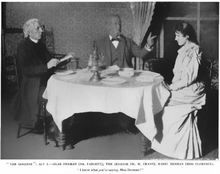The Senator (play)
| The Senator | |
|---|---|

Scene from the play
|
|
| Written by | David D. Lloyd and Sydney Rosenfeld |
| Date premiered | January 13, 1890 (New York) |
| Place premiered | Star Theatre |
| Original language | English |
The Senator was a popular 1890 comedic play by David D. Lloyd and Sydney Rosenfeld, also made into a 1915 silent film.
Rosenfeld, a prolific writer and adapter of plays, completed the play after Lloyd died; it is not known for sure how much Rosenfeld did to revise the text. He himself claimed to have made major revisions (though acknowledging the unfairness of claiming such when Lloyd could not dispute it), while some critics suggested he just made minor alterations, perhaps supposing that Rosenfeld himself was not capable of producing such fine product. After initial performances outside New York (it was first performed in St. Louis) it debuted at the Star Theatre on Broadway on January 13, 1890, and ran for 119 performances.
The play starred actor William Henry Crane and Georgie Drew Barrymore. After it closed on Broadway, Crane continued to perform the play for the next three seasons, and it was considered one of the highlight roles of his career, as well as Barrymore's.
The plot is based on a true story of a claim for damages from the War of 1812 for the sinking of the brig General Armstrong which was not resolved for 70 years.
The title character of Senator Hannibal Rivers was modeled on Senator Preston B. Plumb of Kansas. When Plumb saw the play he was surprised to see Crane wearing a stovepipe hat, commenting to Crane that "I never wore a silk hat in my life, and my creditors wouldn't know me for myself in a head piece like that." Crane threw the hat down and declared he wouldn't wear it again, though he continued to do so, at least in New York. According to a biography of Plumb, before one performance of the play in Washington, D.C., Senator Blackburn of Kentucky "told Crane to vigorously rub the back of his neck with a large white handkerchief when excited as that was a habit with Plumb in debate." Twenty-four U.S. Senators were in the audience for the performance, and upon seeing that move "roared with laughter" though the general audience had no idea of the cause.
...
Wikipedia
